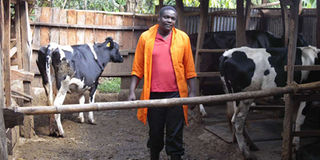The dairy cows that turned my life around

Sammy Murithi on his dairy unit (above) and on the farm where he grows different kinds of fodder in Chuka.PHOTO| CAROLINE WAMBUI| NMG
What you need to know:
- Murithi started with two cows worth Sh100,000 in 2015 offered to him by Upper Tana Natural Resources Management, a project funded by the government, International Fund for Agricultural Development and Spanish Trust Fund, among others.
- Farming brachiaria grass is a low risk and highly profitable venture that can help farmers boost meat and milk production
- Lupin is rich in protein and when combined with brachiaria and calliandra, it helps dairy production becomes profitable due to high milk offered.
Some 15km from Chuka in Magumoni, Kathatwa sub location sits Murang’a Farm, owned by Sammy Murithi, 29, who keeps dairy cows.
Murithi started with two cows worth Sh100,000 in 2015 offered to him by Upper Tana Natural Resources Management, a project funded by the government, International Fund for Agricultural Development and Spanish Trust Fund, among others.
From the two animals, he increased the herd to four making his kin entrust him with the family’s 12 acres and a herd of 12 animals. The farm, which he runs now is home to 18 cows and several goats.
“I had no choice but to grow the farm,” says Murithi, who has now acquired vast knowledge on animal husbandry.
“My life had been turned upside down by drug addition that I started while in secondary school and this was an opportunity for me to change it for the better.”
Homemade diary meal
Murithi feeds his animals at 6am every day immediately after milking with 20kg of silage and a portion of his homemade dairy meal. At 11am, the animals are fed on brachiaria.
The next feeding happens after milking at 6pm where he offers the animals the home-made dairy meal.
“The dairy meal contains crushed maize and the cobs, calliandra, lupin bean, soya, sunflower and Maclic salt,” offers the farmer, who has acquired machines to make the feeds.
He ensures that the crushed maize and cob are in a higher proportion with minimal ration of calliandra and lupin, among the others.
“Sunflower and lupin beans offer high plant protein with up to 50g per 100g.Lupin is also high in fibre and protein and low in fat and starch,” says Murithi.
The farmer grows brachiaria fodder which he says is not only hardy, but also drought-tolerant and is little affected by pests and diseases.
Brachiaria,calliandra,lupin
Paul Mambo, a consultant with SNV, a Dutch organisation, says that if brachiaria is well-manured and offered CAN fertiliser, a farmer can get a crude protein of up to 17 per cent equivalent to the protein in the dairy meal.
Mambo adds that lupin is rich in protein and when combined with brachiaria and calliandra, it helps dairy production becomes profitable due to high milk offered.
“Initially, I was milking 12-15 litres per cow, but thanks to my new feeding regime that includes brachiaria, I get an average of 80 litres from the four cows that are lactating,” offers Murithi, adding that for the other animals, three are in-calf, eight are heifers and three are bulls
He sells the milk to Thuita Co-operative Society at Sh38 per litre.
“Farming brachiaria grass is a low risk and highly profitable venture that can help farmers boost meat and milk production,” he explains, adding that he also grows other fodder that include maize for making silage, Boma Rhodes grass, sunflower and calliandra
Murithi attributes his changed life to the animals, which have not only turned around his life for the better but also enabled him to help others. He has employed two recovering drug addicts on his farm.
But what compelled him to strive to change for the better?
“The death of my brother in 2009, who was also doing drugs. I was introduced to drugs at 14 in Form Two while at Chogoria Boys. I was hooked to heroin and cocaine but my parents took me to Asumbi Treatment Centre,” he says, advising anyone having drug addiction problems to seek help.





